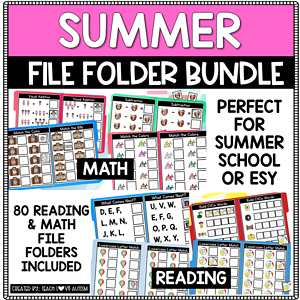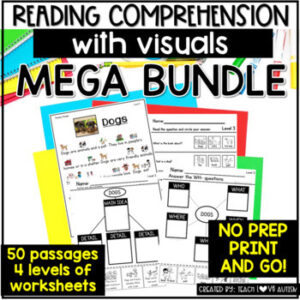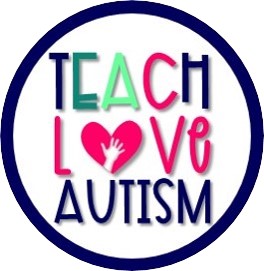Extended School Year Ideas for Special Education
Sharing is caring!

Looking for some extended school year ideas because you are teaching ESY this summer? When summer rolls around, most teachers are dreaming about beach days and sleeping in—but for those of us who’ve signed up to teach Extended School Year (ESY), it’s a different kind of summer vibe. Whether you’re new to ESY or you’ve done it before, let me just say this: you’re a rockstar.
Teaching in a self-contained classroom during the summer can feel like a whole new world, we were just talking about all this in my facebook group called the Teach Love Autism Community. The days are shorter, the schedule is lighter, but the need for structure and support is still very real. So if I were teaching ESY this year, here’s exactly how I’d approach it—with extended school year ideas that keep things fun, low-prep, and manageable (for the students and for me).
Structure Without the Stress
Even during summer, structure is a must—especially for our students with disabilities. One of my extended school year ideas is I’d keep a visual schedule front and center and follow a predictable routine to reduce anxiety and support smooth transitions. Here’s my ideal day:
- Arrival & Morning Routine – Think calendar, greetings, and a quick preview of the day, including the review of any scheduled meetings, important tasks to focus on, and ensuring a positive and organized start to the day ahead.
- Academic Stations – Simple review tasks tied to IEP goals (nothing brand new), designed to reinforce previously learned material and provide students with an opportunity to practice essential skills at their own pace while tracking their progress through engaging activities tailored to individual learning needs.
- Snack & Movement Break – GoNoodle, bubbles, or time outside if it’s nice!
- Life Skills Practice – Engaging in easy cooking, mastering basic chores, or navigating real-life scenarios to build confidence and independence is a great extended school year ideas.
- Social Skills or Story Time – Use adapted books and act out mini-scenarios, encouraging participation and collaboration among children, while fostering their imagination and enhancing their understanding of social cues and interactions.
- Goodbye Routine – End with reflection, music, or a fun closing game.
The goal? Keep it consistent without overcomplicating it. Summer school doesn’t mean summer stress.
ESY Activities for Special Education That Actually Work
You don’t need a brand new curriculum for a few weeks of summer school. What you do need are Extended School Year ideas and activities for special education that are engaging, hands-on, and low-prep. These are a few of my tried-and-true favorites:
- File Folders & Task Boxes – Perfect for independent practice and skill maintenance.
- Life Skills Adapted Books – Focus on summer safety, hygiene, or simple routines.
- Sorting Tasks with Real Photos – Think: cleaning items, cooking tools, or community helpers.
- Crafts & Cooking – Keep it simple (paper plate suns, trail mix, fruit kabobs).
- Calm Down Kits or Break Boards – Support self-regulation when that summer heat kicks in.
Recommended products
-
Editable Visual Schedule for Special Education & Autism | Daily Routine Schedule (Printable and Digital Version)
$13.95 -
Morning Meeting | Calendar Time | Circle Time | Bundle for Special Education
$37.50Original price was: $37.50.$28.00Current price is: $28.00. -
ESY Math and Reading File Folders Summer Activities for Centers or Summer School
$28.00Original price was: $28.00.$22.50Current price is: $22.50. -
Reading Comprehension Passages and Worksheets with Visuals for Special Education Bundle
$150.00Original price was: $150.00.$110.00Current price is: $110.00.
These activities help reinforce important skills without eating up your planning time.
Keep It About Maintenance, Not Mastery
One of the most important things to remember about Extended School Year ideas is that it’s not about pushing for major progress—it’s about preventing regression. The focus is on maintaining the growth your students have already made during the school year. And how do we make that happen? Simple: stick to the IEP goals.
Before ESY starts, I’d pull each student’s IEP and flag the goals that were noted for summer services. Those become your guiding light. You don’t need to reinvent the wheel—just build simple activities and short sessions that allow students to practice those specific skills.
Here are a few practical ideas for tracking data and working on goal maintenance during ESY:
- Use a Daily Data Sheet – Create one sheet per student with each goal listed and space for notes/checklists. Keep it on a clipboard or in a folder you carry during instruction.
- Track During Naturally Occurring Routines – You don’t have to sit one-on-one with a clipboard every time. Observe and jot down data during group work, transitions, or social activities.
- Limit Data Collection Days – Pick 2 days per week to take focused data so you’re not overwhelmed. The rest of the week can be for casual observation and instruction.
- Color Code Goals – Use different color pens or stickers to label goals (social, academic, behavior) so you can quickly glance and go.
And here’s the thing—you don’t need a spreadsheet masterpiece. You just need consistent, meaningful snapshots of how the student is doing. That way, when school starts again, there’s a clear picture of what skills stayed strong and where extra support might be needed.
Make It Purposeful and Playful
Remember—Extended School Year isn’t about teaching new content. It’s about helping students maintain what they’ve learned and continuing the routines and supports they rely on. So don’t stress about covering everything. Focus on what matters most: connection, communication, and consistency.
And don’t forget about YOU. If I were teaching ESY, I’d make sure my plan was sustainable. I’d prep in small batches, drink my iced coffee guilt-free, and choose activities that made learning fun for my students and for me.
So if you’re walking into ESY this summer, breathe. With the right extended school year ideas, you can build a classroom that works, even in July.
Head to the TLA shop to look for resources to fit the needs of all the students you will be working with!
You’ve got this. And yes, you still deserve that beach day.









